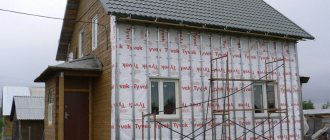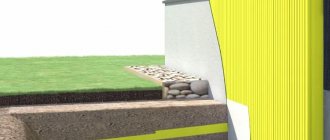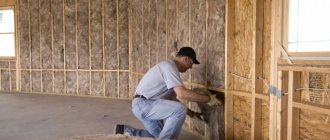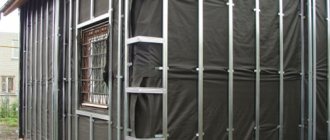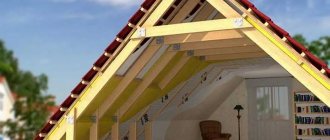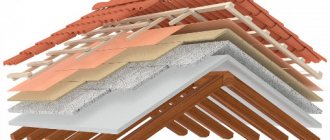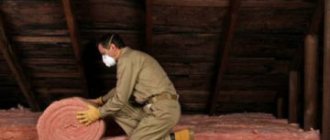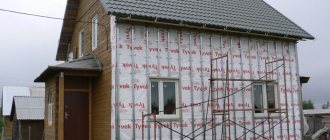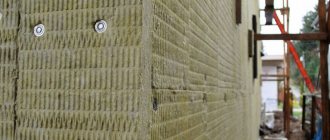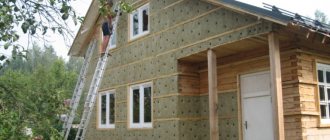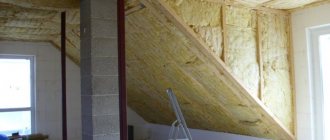Laying heat-insulating materials under the exterior of the house significantly reduces heat loss, and therefore heating bills. In addition, if you know how to properly insulate a house under the siding, you can additionally count on improved sound insulation of the walls.
Scheme of the “pie” of siding with insulation Source repair-need.ru
Insulation under siding: types of insulation
When choosing insulation, several indicators are taken into account :
- the material from which the walls are made;
- weather;
- insulator characteristics;
- the financial side of the issue.
The cheapest material is not always the worst.
Manufacturers produce insulation materials designed for various wall materials, operating conditions:
- mineral wool;
- Styrofoam;
- expanded polystyrene;
- polyurethane foam;
- extruded polystyrene foam;
- glass wool
When calculating the amount of insulation, take into account the thickness of the material and the number of layers of coating.
It is important to choose the right material from a large number of offers on the market Source in.pinterest.com
Features of thermal insulation of wood
Any wood has a property that allows it to absorb moisture. Using various impregnations, it is possible to reduce the hygroscopicity of such a material, but it is not possible to completely eliminate this property. If there is an effective ventilation system, then the moisture can evaporate quite quickly and efficiently and it will not have time to have any negative effect on the wood, which will allow you to maintain a good microclimate in a village or city house.
But the disruption of the movement of air masses leads to the fact that condensation begins to accumulate and the tree begins to swell, which is why fungus and rot begin to appear on it, and the air begins to smell characteristic. In order to avoid such problems, it is recommended to follow these tips:
- use exclusively insulation with good vapor-permeable characteristics;
- It is better to insulate dry walls, but not wet or damp ones;
- cover the thermal insulation on both sides with a waterproofing membrane;
- leave a small air gap between the finish and the insulation.
As a rule, these are those made on an acrylic base. And of course, the surface must be prepared as much as possible before insulation. In addition, the logs themselves or the surface of the outer boards should not be damaged by pests such as bark beetles.
Basic requirements for insulation under siding
The main requirement for an insulator is low thermal conductivity. The lower this indicator, the more heat is retained in the building. Mineral wool and extruded polystyrene foam, in addition to low thermal conductivity, have good sound insulation properties.
When choosing a material for insulating a house, pay attention to:
- moisture resistance;
- susceptibility to fungal attack;
- resistance to temperature changes;
- durability;
- fire hazard;
- environmental friendliness.
Some types of insulation for the walls of a house outside under the siding are installed with special membranes that absorb moisture.
The manufacturer must indicate all characteristics of the insulation on the label Source kak-stroil-dom.ru
The issue of vapor permeability
The building wall in SNiP is described as a multi-layer enclosing structure. Interior decoration - wallpaper, for example, plaster, the wall - monolithic, with voids, double, and exterior decoration - this is the simplest version of its construction. If thermal insulation is assumed, the design becomes much more complex.
Obviously, the ratio of different materials in such a “pie” cannot be random and is subject to a certain pattern. It sounds like this: the ability of a material to remove steam should increase from layer to layer from the inside out.
Why is this necessary? In a residential building, a constant source of steam formation is not only a gas stove or water in a sink, but also people, animals and plants. Steam released through breathing or during washing and cooking is removed using a ventilation system or simply through an open window, but also through the walls of the building. If this does not happen, moisture accumulates in the room, and condensation falls on surfaces - walls, furniture, clothing.
This case is best illustrated by a bathroom in a multi-story building, where there is almost never good ventilation. After taking a bath or even a shower, the entire room from the ceiling to the handles on the washing machine becomes wet. Why? The bathroom is finished with tiles or tiles; this material is completely vapor permeable, and therefore moisture is not removed at all. The dew point is condensation, located inside the living space on the walls.
- Option two is thermal insulation inside. A solution that builders try their best to avoid. Compared to a brick wall, the vapor permeability of insulation is much higher, therefore, in the design - finishing / insulation / wall, the most vapor-permeable element is mineral wool or polystyrene foam. Condensation falls in the thermal insulation area and quickly destroys the material, which makes waterproofing necessary.
- If insulation is carried out from the outside, then the “pie” looks like this: wall/insulation/cladding, and, again, the dew point falls on the thermal insulation layer, since the cladding absorbs moisture much less. To prevent this from happening, the insulation is protected with hydro- and vapor barrier. Then the dew point ends up in the air gap between the wall and the insulation, for which purpose a substantial ventilation gap is left here during installation.
Installation of siding without insulation
But if the walls of the building themselves have high thermal insulation characteristics - a brick wall of sufficient thickness, for example, then there is no need to additionally insulate them, but they do need to be protected from wind and rain. Do you need waterproofing and wind protection for siding without insulation?
To avoid moisture accumulation, a ventilation gap is left between the finish and the wall. Therefore, installation of finishing without thermal insulation is quite possible, but without sheathing - not. If there is an air layer, then condensation accumulates on the inner surface of the finish, which is insensitive to water; if not, then directly on the wall, which leads to its destruction.
- Is waterproofing required here? It is not needed, since during sheathing its task is to protect the insulating layer, which in this case is not used.
- Do you need a vapor barrier for siding without insulation? Vapor barrier or wind protection is a vapor-permeable membrane that allows steam to pass in both directions, but water only in one direction, away from the heat-insulating layer. Again, if it is not there, then there is nothing to protect. Siding technology without insulation
Installation without heat and vapor barrier is much simpler.
- The surface of the facade is cleaned. Old finishing, if any, must be removed. If you plan to cover a wooden house with siding without insulation, then before work you should caulk the cracks between the beams or logs - this procedure will significantly reduce heat loss.
- A sheathing is fixed to the surface - made of a galvanized metal profile or a wooden beam treated with an antiseptic. The thickness of the timber should not be less than 50 mm, despite installation without thermal insulation.
- The pitch between the frame elements, as well as the direction - vertical or horizontal, are determined by the type of siding - lamellas, panels, and installation method.
- The material is fixed to the sheathing using the usual method: first, the starting strip is fixed, then the corner elements and near-windows, and the connecting profiles are fixed, if necessary.
- Then the panel is inserted into the groove of the starting strip and fixed to the sheathing. The fastening is not rigid; a film under the siding without insulation is not needed.
The photo shows one of the working moments.
Advantages and disadvantages of materials
- The positive qualities of mineral wool include low cost. It has a low thermal conductivity, good noise insulation properties, but is not resistant to moisture and is easily flammable. To protect the material from getting wet, membranes that absorb liquid are additionally installed.
Cotton wool in rolls is more often used on horizontal surfaces, since it does not protect joints well and must be laid in 2 layers. The wool in the slabs has a denser structure, so it is used to cover the walls in 1 layer.
Mineral wool is produced in slabs and rolls Source legkovmeste.ru
- Polystyrene foam has a porous structure. This material is filled with gas bubbles. It retains heat well. Manufacturers produce slabs of various thicknesses. You can choose the material based on your needs. It is low cost, lightweight, and easy to install. The main disadvantage is that it is spoiled by rodents. It conducts air poorly, so a room with such insulation can accumulate moisture. In addition, polystyrene foam has a short service life - 12-15 years; it burns and at the same time releases toxic substances.
Foam boards of various thicknesses Source gidpokraske.ru
What is the difference between a vapor barrier and a wind barrier?
When people talk about vapor barriers, they usually mean vapor barrier films for protecting roofs and roofing coverings. These materials provide only protection from atmospheric moisture. They are thin, light, and relatively inexpensive.
Wind protection has a vapor barrier function, but has a more massive structure; often these types of films are made on a polyamide frame to withstand the effects of wind. In addition, they use additives that protect the material from the destructive effects of ultraviolet radiation - ventilated facades can be mounted from cladding slabs with a gap of up to 20 mm and these gaps create access to sunlight (on the sunny side, the total illuminated spot under the cladding can be 300% of the gap width or more , depending on the design). These films are much heavier, more tensile strength, and more expensive.
Important! Do not use materials not intended for this purpose as windbreaks. You can disrupt thermoregulatory processes, the process of removing excess moisture from the main structures, thereby activating the destruction of materials under the influence of condensation.
Video description
We will dwell in more detail on insulating a house with polystyrene foam.
Find out how safe polystyrene foam is in our video: See also: Catalog of companies that specialize in insulating country houses.
- Expanded polystyrene is used to insulate building foundations. The material resists moisture well and conducts heat poorly. The main disadvantage is the high cost. Therefore, the use of the material is limited to the foundation of the house.
Sometimes polystyrene foam granules are used Source fasaddomstroy.ru
- Polyurethane foam (PPU) has a liquid structure, low thermal conductivity, and is resistant to moisture, mold, and rodents. The material is applied using special equipment. Good sound insulator. Application in liquid form allows you to cover the surface without joining seams. The disadvantages are poor resistance to ultraviolet radiation. It is necessary to have skills in working with equipment for applying to the surface.
This is how polyurethane foam is sprayed Source buildes.ru
- Extruded polystyrene foam is resistant to moisture, mold, and retains heat well. The big disadvantage is poor fire resistance.
Extruded polystyrene foam boards Source pt.decorexpro.com
- Glass wool is fire resistant, lightweight, easy to install, and cheap. This is one of the most popular materials. The disadvantage is the need for special human protection during installation of the material.
Glass wool is available in slabs and rolls Source saucyintruder.org
Methods of insulating panel walls from the outside with modern materials
Wood is a combustible material with low hydrophobicity and high thermal conductivity. Therefore, it is necessary to insulate the facade with water-repellent, fire-resistant and heat-insulating compounds. These include: polystyrene foam, mineral wool, glass wool. They are also highly flexible and resistant to chemical or biological agents.
Modern methods of laying protective materials before covering with siding guarantee a comfortable temperature in a frame-panel building, both in summer and winter. The building materials market offers a large number of types of siding. The latter, according to its characteristics, is divided into: base, wooden, metal, cement and ceramic. For exterior work, an inexpensive option is often used - polyvinyl chloride (PVC) siding. This material is easy to install, does not deform, does not corrode, and is easy to clean. Cladding is not a complex type of work, so you can do it yourself.
How to insulate the wall of a house under siding
The covering of different walls requires their own insulating material. An incorrectly selected insulator can make the room damp; some of them have a short service life.
Brick house
For this type of wall, the best option is basalt insulation (a type of mineral wool) or expanded polystyrene. The material is easy to install, cheap, and has good insulating qualities.
Polyethylene foam has good thermal conductivity, but it is necessary to invite specialists to install this material.
Polystyrene foam is lightweight, easy to use, and cheap. This is the most popular insulation.
It is better to insulate the foundation of a house under siding with polystyrene foam. This material is most resistant to moisture and has a dense structure.
Insulation of a brick house Source mirstrojka.ru
House made of foam blocks and aerated concrete
Aerated concrete walls have high vapor permeability. If you choose the wrong heat insulator, the wall may become moldy and begin to rot. The insulation should not disrupt gas exchange between the house and the environment.
Mineral wool is used on such a surface. It has high vapor conductivity and, in combination with aerated concrete, will preserve the microclimate in the room.
Polyurethane foam performed well on such walls. If you spray this material onto the surface, you can avoid joining seams. This will reduce heat loss.
You should not install polystyrene foam or expanded polystyrene on walls made of aerated concrete and foam blocks. They have poor vapor permeability.
Insulation of walls made of aerated blocks Source besplatka.ua
Wooden houses
Wood has low thermal conductivity, but is not resistant to fire, moisture, or insects. When choosing which insulation is best for the outside walls of a wooden house under siding, take into account that it should eliminate these shortcomings. The optimal choice for wood is polyurethane foam. It is lightweight and retains heat well.
Spraying polyurethane foam on the wall of a wooden house Source remontik.org
For a wooden house, fiberglass and mineral wool impregnated with special fire-resistant compounds are used.
Wooden or metal frame?
You also need to decide on the type of frame, and whether it will be present at all.
A sheathing is installed on the vapor barrier layer. It can be made of wood or metal profile. The lathing made of wooden beams is a reliable frame for insulation. The material has high strength and temperature resistance. Secure with self-tapping screws or nails
When creating such a sheathing, it is important to maintain the evenness of the protrusion of the structure to preserve the plane
Wooden frame ready for siding installation
Galvanized metal profile is a durable material for creating a frame for insulation. However, the high thermal conductivity of the metal can cause the sheathing to freeze. The main advantage is ease of installation.
Metal frame for siding
Technology for insulating a house under siding
There are 3 types of insulator installation: gluing roll materials to the surface and fixing them to the frame:
- In the first case, glue is applied to the wall and covered with insulation. Leave for some time to set. The layer is secured with lathing.
- The frame method is convenient for slabs. This material is more rigid; fastening to the wall is carried out with screws, nails, and glue.
Before installing the blocks, check the level. First, a profile is installed on which the plates are placed.
The installation direction is chosen by the wizard. It is more convenient for some to install blocks, moving from the corner to the center, for others it is easier to start work from the center of the surface. This is not of fundamental importance. The main thing is the quality of installation.
- The third method of installing insulation under siding for a wooden house is installation along a cross frame.
The principle of cross insulation Source myecoteplo.com
Experts consider this method the most successful, although its cost is more expensive. The principle of the method is that first, insulation is installed on the frame in a horizontal direction. Then a sheathing is placed on it, and an insulator is placed on it in the vertical direction. This installation method minimizes heat loss.
If you plan to cover with a membrane, it must be applied from bottom to top. The sheets are fixed using a construction stapler. The spacing of the fastenings is 20 cm. The material is placed overlapping with an overlap of 10 cm. For complete insulation, the joints are sealed with tape.
Advantages of ready-made mixtures
The quality of floor coverings is influenced not only by the material they are made of, but also by the strength of the base. It should be as smooth as possible and withstand all loads without problems, and not change its linear dimensions during temperature fluctuations. Modern self-leveling mixtures fully meet the most stringent consumer requirements.
Self-leveling mixtures have a number of advantages
The advantages of the material include important characteristics.
- Great mechanical strength. This property applies only to cement-based mixtures; gypsum has worse parameters. But each floor covering has its own individual requirements; some are satisfied with the characteristics of gypsum.
- Manufacturability. Working with such materials is much easier than making traditional screeds using semi-dry cement-sand mortars for lighthouses.
- Minimum shrinkage parameters. When hardened, the material almost does not lose its original horizontal characteristics, does not sag, does not swell, or cracks.
- High adhesion values. If you fully follow the manufacturer's recommendations, the likelihood of detachment is almost eliminated. Due to such properties, it is possible to significantly reduce the thickness of the layer, and this is a significant saving in expensive compounds.
To ensure high-quality floor leveling, it is necessary to strictly follow the workflow technology
The only drawback is the relatively high price. But professionals know the secrets to reducing the estimated cost of floor repairs; savings can reach significant amounts.
Tips for installing insulation
- If you plan to install vinyl siding, you should use galvanized screws and nails. This will protect the metal from rust and the structure will last longer.
- When choosing mineral wool, you should ask whether it is treated with a fire-retardant mixture.
- The joints of the insulator blocks must be sealed to avoid moisture ingress.
- If you plan to use mineral wool, it is better to install blocks on a vertical surface. They have a denser structure and therefore have better insulating qualities.
- Membranes are laid on polystyrene foam and mineral wool. If you do not do this, condensation will begin to accumulate in the house. An additional ventilation gap is created by the sheathing.
- Areas around windows and doorways require additional insulation. The insulator is also reinforced at the corners of the building.
When insulating walls, you need to pay special attention to windows Source myprofnastil.ru
- To install the heat insulator, no leveling of the walls is required.
- The calculated amount of material should be increased by 5 - 7%, since some will have to be cut off during installation.
- To fix the insulator, dowels with disc-shaped caps are used. At least 5 dowels are used for each block.
When choosing how to insulate a frame house under siding, take into account the ability of the material to conduct moisture. Mineral wool is popular among consumers. It is cheap and easy to apply to the surface. Experts advise insulating such buildings using polyurethane foam.
Windproof film for walls: purpose, structure
Facade insulation film is used for:
- protection from atmospheric moisture when installing the so-called thermal cake;
- stopping cold (warm) outside air in order to reduce heat loss in the building;
- as a barrier - in ventilated facades it protects the insulation from snow blowing in and its accumulation under the facing material.
Water vapor barrier films for facades have the following structure:
- Waterproofing vapor-proof films consist of two layers. The inner layer is a non-woven artificial material, among the fibers of which moisture accumulates and condenses, and is removed by gravity down this layer. The outer layer is waterproofing and waterproof. It is made by spraying a thin layer of polyethylene (such films are cheaper) or acrylate (expensive branded films). They are installed with a small gap (up to 30 mm) from the insulation; there should be holes at the bottom to remove condensate.
- Vapor-permeable membranes (diffusion) – a higher class of wind protection. They consist of three layers: the outer layers do not allow moisture and air to pass through, but allow water vapor to pass through. In the center between these layers there is a vapor-conducting layer, which removes excess moisture to the outside. The outer layers are made of non-woven polyester, the inner layer is made of acrylic fabrics with a hygroscopic response mechanism. They can be installed hermetically close to the insulation material.
For high-rise buildings, reinforced films with a thicker coating can be used, which provides them with additional tensile strength. Such films can be mounted on umbrella-type mounts. The main condition is to ensure sufficient tension so that the wind protection does not “flap” under increased wind pressure in bad weather.
All films are installed taking into account the continuity condition: there should be no gaps between the wind protection strips, the joints are overlapped or sealed using construction tape. On high-rise buildings and tall structures, the film is placed vertically along the facade; on one-story and two-story facades, the roll can be rolled out horizontally, forming an overlap to ensure drainage (the lower one is launched under the top sheet).
How much does it cost to cover a house with siding?
The cost of insulating a house depends on several components:
- material prices;
- wall sizes;
- insulation consumption;
- use of additional materials (membranes, fasteners, surface pre-treatment);
- the cost of the master’s work (the higher the qualifications of the specialist, the more expensive you will have to pay).
Various manufacturers set their own prices for insulators. The cheapest is polystyrene foam.
Since there are a lot of variables for determining the price, it is difficult to give an exact figure, even knowing the area of the walls that will be insulated. The price can range from 200 to 800 or more rubles per square meter and any specialist will name the final cost only after inspecting the house and taking measurements. The average cost of insulating a house is 43,500 rubles.
Branded wind protection
- ROCKWOOL is a vapor-permeable membrane from a well-known brand. The price of a roll of 70 m2 is about 1000...1200 rubles. Used in professional construction.
- “Ondutis” is a brand spun off from the famous manufacturer Ondulin. The classic (simplest) version of wind protection - retail is offered at 600 rubles per roll of 35 m2 (all prices as of February 2022). Diffusion membranes for walls from this manufacturer cost about 4,000 rubles/roll. Today it is actively advertised for promotion in the market - the brand is relatively new.
- Wigofol is a Polish brand, relatively inexpensive. Simple windproof films based on non-woven fabric. The price starts from 500...600 rubles. per roll. More suitable for small buildings.
- TechnoNIKOL is a well-known Russian brand. Provides films at a price and quality similar to imported manufacturers.
- The Izospan brand is one of the oldest manufacturers of water vapor barrier materials in the Russian Federation. The cost of membranes is about 2300 rubles. per roll.
- Elite films and membranes are presented by European manufacturers. The price can exceed the figure of 10 thousand rubles per roll. But they guarantee the quality of the products. If you need real fire resistance indicators, purchase products from this category.
Unnamed windproof films produced in other countries (and even “membranes”) can be found below 500 rubles/roll. We do not recommend purchasing it - no one will return your wasted money.
"Eryap Plastic"
Most of the products with polyurethane foam coating are supplied from Turkey. Since 2001, it has been providing the domestic market with high-quality building materials in the mid-price category.
In addition to siding, the company can purchase high-quality and reliable insulation for panels for cladding a wooden or brick house.
Advantages of American Siding siding
The “American Siding” series combines the best qualities of a facing material for finishing the exterior of a brick or wooden building. The siding is quite durable, is not susceptible to cracking in severe frosts and retains its original color.
All panels are multi-colored and have a smooth transition. Even if you take a close look at the facade, you might think that it was not vinyl siding that was used to decorate the outside of the house, but natural stone or valuable wood.
Facade cladding with your own hands
You can cover your house with siding yourself. First you need to calculate the amount of thermal insulation required. Having measured the area of the walls, you need to select the thickness of the heat-saving field. To reduce heat loss, a layer 8-10 mm thick is required, however, if funds allow, the thickness of the insulation can be increased to 15 mm.
After installing the insulation, it is necessary to install a protective layer. Siding sheathing will protect the thermal insulation layer from meteorological factors and extend the service life of the insulation. Installing insulation under metal siding or vinyl sheathing is very popular.
Chemical components of the material and microscopic dust can cause an allergic reaction or respiratory disease. After work, be sure to take a warm shower and change clothes!
